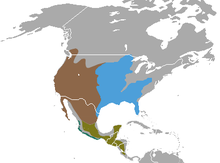Spilogale
| Spotted skunks | |
|---|---|
 |
|
| Western spotted skunk (Spilogale gracilis) | |
| Scientific classification | |
| Kingdom: | Animalia |
| Phylum: | Chordata |
| Class: | Mammalia |
| Order: | Carnivora |
| Family: | Mephitidae |
| Genus: |
Spilogale Gray, 1865 |
| Species | |
|
Spilogale gracilis Merriam, 1890 |
|
 |
|
| Spotted skunk ranges | |
Spilogale gracilis Merriam, 1890
Spilogale putorius (Linnaeus, 1758)
Spilogale pygmaea Thomas, 1898
Spilogale angustifrons Howell, 1902
The genus Spilogale includes all skunks commonly known as spotted skunks and is composed of four different species: S. gracilis, S. putorius, S. pygmaea, S. angustifrons.
Mammalogists consider S. gracilis and S. putorius different species because of differences in reproductive patterns, reproductive morphology, and chromosomal variation. However, interbreeding has never been falsified. The name Spilogale comes from the Greek word spilo, which means "spotted", and gale, which means "weasel". Putorius is the Latin word for "fetid odor". Gracilis is the Latin word for "slender". Several other names attributed to S. putorius include: civet cat, polecat, hydrophobian skunk, phoby skunk, phoby cat, tree skunk, weasel skunk, black marten, little spotted skunk, four-lined skunk, four-striped skunk, and sachet kitty.
The western spotted skunk (Spilogale gracilis) can be found west of the Continental Divide from southern British Columbia to Central America, as well as in some parts of Montana, North Dakota, Wyoming, Colorado, and western Texas. Eastward, its range borders that of the eastern spotted skunk (Spilogale putorius). Spilogale gracilis generally occupies lowland areas but they are sometimes found at higher elevations (2600 m). Although the western spotted skunk is now recognized as S. gracilis, previously, skunks west of the Cascade Crest in British Columbia, Washington, and Oregon as a distinct subspecies (S. p. latifrons).
Spilogale putorius is found throughout the central and southeastern United States, as well as, northeastern Mexico. In Mississippi, S. putorius is found throughout the whole state, except for the northwestern corner by the Mississippi river. In the Great Plains, there has been an observed increase in the geographical range of these skunks, and the cause of this is thought to be a result of an increase in agriculture. This would lead to an increase in mice, which happen to be one of the primary prey for S. putorius.
...
Wikipedia
